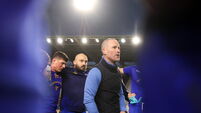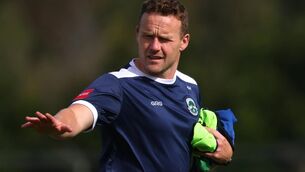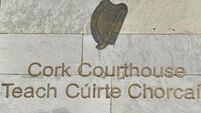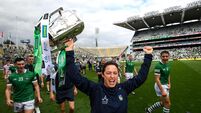With Micko at the wheel all roads led to Laois, not through it
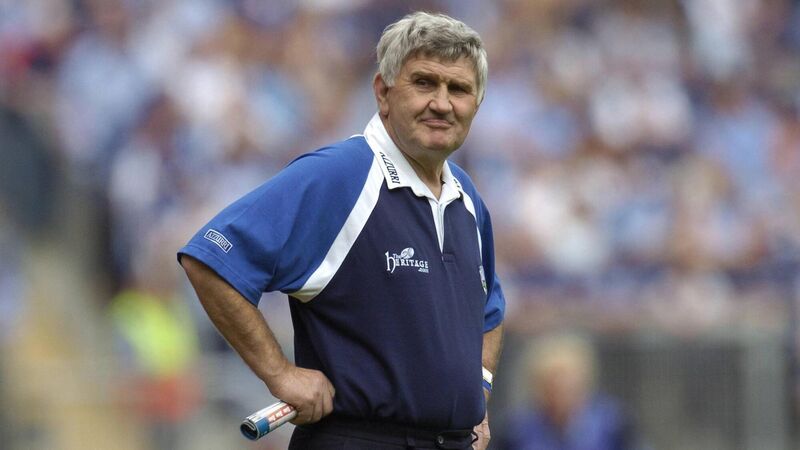
HIGH SUMMERS: Mick O'Dwyer takes charge of Laois in the 2006 Bank of Ireland Leinster Senior Football Semi-Final against Dublin. Pic: Ray Lohan / SPORTSFILE
John Bruton wore a smile as wide as the motorway itself as he cut the ribbon on a new £48m Portlaoise bypass in the closing years of the last millennium. It was one of those days when it’s good to be Taoiseach. The frivolities continued as he climbed into a 1936 classic Bentley and embarked on a ceremonial tour of the 12-kilometre stretch that was now winding its way through what had been for centuries a largely undisturbed swath of the rural Midlands.
The new road would take a dozen minutes off the trip from Dublin to Cork or Limerick. Just as significant were the 24,000 vehicles diverted from the county town every single day. Bruton, though, took his eyes off the road and reached for the stars when putting the true value of the asphalt underneath his feet into perspective.
He spoke about days gone by when people in parts of rural Ireland couldn’t hope to do certain things if they weren’t a resident of Dublin, or London, or New York. And he declared that the only limitations as the year 2000 approached and the world changed were the inhibitions and the boundaries in our minds.
The internet was in its infancy, remember, and if the Irish had always lacked a touch of self-belief then that was manifested to a raw degree in counties like Laois. Bruton saw shafts of light amid these internal shadows as he praised the younger generation for the limitless confidence with which they went about their lives.
“Young people in Portlaoise can do anything they want here in Portlaoise,” he said.
The politician in him would have had businesses and farming and worldwide markets in mind, but his speech was already playing out in O’Moore Park and on the hallowed turf off Jones’ Road. The county’s ladies footballers were refusing to give up the ghost despite a haunting run of losses in All-Ireland finals that had by then swelled to seven. The minors hadn’t long made their first September ascent up the Hogan Stand steps.
The 1997 underage vintage would embark on that very same climb just months after Bruton’s visit but, while the Ladies would finally conquer their demons in 2001, an all too familiar catalogue of doubt and apathy would settle again on the men’s game and it threatened to wither the county’s golden crop before it could be fully gathered.
This was all before Micko.
***
You can’t understand the familiar pall that hung over football in the county so soon after those back-to-back minor All-Irelands until you understand Laois as a county. A cog at the centre of the island, it boasts miles of road and rail tracks that connect all the major urban centres in the 26 counties and yet it exists, if at all, as an afterthought in the national psyche.
Laois has always served as a thoroughfare rather than a destination. For generations it has been taken in through the windows of a car or a carriage. A flat, unremarkable backdrop observed with half-interest through fogged-up windows. To tell someone you were from Portlaoise was to all but guarantee a response that would find its way to the door of the high-security prison on the old Dublin Road. And only in passing, naturally.
The locals are all too aware of this.
Laois is the birthplace of the mythical hero Fionn Mac Cumhaill. The first shot of the 1916 Easter Rising was fired by Patrick Ramsbottom, a member of the Laois Volunteers, in Colt Wood near Abbeyleix. The first airplane built and flown in what is now the Republic? Put together in Portlaoise.
Any number of these nuggets lie unnoticed around the landscape and, though Laois can boast a roll call of people past and present who have made names for themselves in all walks of life, the county’s image problem is tackled in the love letter masquerading as a poem that is Laura Murphy’s ‘In Laois I Fly Free’.
‘What’s the best thing about Laois, they’d ask / ‘The road out of it, I’d answer, like I’d never heard the joke before’. Another stanza asks rhetorically who it was that made people from Laois believe that their land was as flat as their accent, or that their culchie status made them somehow ‘less than our neighbours’.
A collaboration with three other artists saw Murphy’s poem set to a ‘haunting visual soundscape’ a few years back. Scenes were filmed in the Slieve Bloom mountains, on the Rock of Dunamase and in Oughaval Woods. All of them locations of stunning natural beauty but rarely taken in by motorists on the M7, or passengers braving the 6.15am train from Cork to Dublin.
To come from Laois was to put up with the gags, the pats on the head, or even the quizzical looks when the odd few heard the name and tried in vain to place it. As if it was some distant cousin from the mother’s side that had settled in America back in the ‘50s and not an actual county here at home. What was Laois, after all, but a mirror image of Offaly in GAA terms: similar population and midland location but without the Leinster or All-Irelands and the Biffos’ swelling chests.
This is the county that awaited Mick O’Dwyer in 2003.
***
The first breadcrumbs that would take him to their door had been scattered in the dressing-room of Leixlip GAA club years earlier when the hotelier and former Laois dual player Declan O’Loughlin togged out for the Kildare outfit alongside Jack O’Shea. The pair’s friendship started to extend to golf, and to golf trips as far south as Waterville. That inevitably sucked them into the orbit of Dwyer himself.
It was O’Loughlin who accompanied Micko - at a time when the latter was one week out from another Leinster final with Kildare - to O’Moore Park in early July of 2002 when Kerry bamboozled Fermanagh in one qualifier and Meath put a double-digit beating on the locals. Why, the Kerryman asked his friend in the stand that day, were so few Laois fans there?
Laois had been one of three sides that Dwyer had singled out with real potential earlier that same year – Westmeath and Tipperary being the others - but the county was already rocking back on its heels despite the plethora of underage graduates that had come through. Promise lost. A future laced with mediocrity and regret already dawning. Again.
Go back to 1986 and a superb Laois football team had won the National League title, beaten All-Ireland champions Kerry in a challenge match - and lost a first round Leinster Championship game to Wicklow. All inside the same month. An almost exceptional hurling side spent the same decade going the distance with the code’s heavyweights but enduring heartache in the title fights. Offaly, damn them, played a huge part in that.
This felt worse.
Ian Fitzgerald, who would lift the Delaney Cup 12 months later, went as far in subsequent years to say that the county was at an “all-time low” after that Meath nightmare. Chris Conway, who would also captain the O’Moores under Dwyer, spoke about the plummeting attendances at club and county level by the time of the great man’s appointment.
O’Loughlin gave an insight into how ingrained the county’s lack of self-belief really was when looking back at his role in getting Dwyer on board. “When he agreed he would train the team my mouth fell open,” he said in 2006. “It was a shock, really. Then I had unbelievable doubts. Was I after selling this wrong?” What if this was just who Laois were?
He wasn’t alone in thinking it.
What he didn’t want was for his friend to commit and for Laois to keep flatlining. What would it say if the greatest manager of them all couldn’t fix us? But the transformation was instant. Conway was “buzzing” at news of the appointment. Fitzgerald felt instantly that his arrival wiped the slate clean. The Meath debacle was forgotten, a new dawn awaited.
“He just brought that can-do attitude to it that we needed at the time,” Fitzgerald said some years later. Here was a man untouched and unbothered by the decades of near-misses and the crushing defeats. Dwyer was a beacon of hope and light, a purveyor of can-do that flipped the mood music from lament to battle march.
It was actually an odd sort of fit.
Here was a prince from the game’s Kingdom taking over a county that hadn’t conquered its province since 1946. A man already of pension age taking on a squad leaning on the promise of youth. A coach who spoke at times even then about retiring from it all to look after his rusting boat back home and now at the helm of the island’s most landlocked county.
And it worked. An open meeting to introduce the new boss at The Heritage Hotel in Portlaoise acted like a homing signal to scattered players, young and old, whose faith had long fled the coop. A series of trials were announced that would build on that sense of buy-in with a county that, like so many others, had so often fielded teams miles short of its best.
Fitness was prioritised. And momentum. An O’Byrne Cup loss to Longford a mere hiccup. When Laois beat Meath in Navan in their opening league game, Sean Boylan referenced the strength in the visitors’ ranks. Dwyer was working on their minds as well as their bodies, injecting belief through victories, and they would win four more league games, draw the other two and beat Armagh in a semi-final.
Years of scar tissue was being lasered in weeks.
Tyrone proved to be a rude wake-up call in the decider but the spring had served its purpose. The likes of Fitzgerald, Fergal Byron, Damian ‘Goggy’ Delaney, Hugh Emerson and Michael Lawlor provided a more experienced spine and balance to the minor grads. A fresh-faced Ross Munnelly injected even more youthful class after a standout Sigerson campaign.
Buttressing it all were those minor boys of ’96 and ’97. Thirteen of them.
Dwyer knew how unusual that was. The volume of new talent available penetrated so deep that Laois fielded seven of those medallists in a challenge match against Carlow the day after they sat out that league semi-final against Armagh for want of places. Some among them would claim central roles at different times throughout the summer that followed.
Wexford were hardly given a second glance in Leinster but it took a late Lawlor goal, via an illegal handpass from Kevin Fitzpatrick, to rescue a draw against Offaly in Portlaoise. A lucky escape. The replay in Tullamore was the day it really clicked and it leached into an epic semi-final defeat of the Dubs which, for some, still ranks as the era’s day of days.
It helped that Dublin couldn’t hit a barn door but decades of doubt had been dispelled, replaced by an explosion of hype that Dwyer did nothing to keep at bay. The media was given the run of training at O’Moore Park before the final with young Munnelly asking why they shouldn’t aim for September itself before being pulled away by the skittish team doctor.
The defeat of Kildare, in front of almost 62,000 souls, let loose a primal scream of emotions. Decades of self-doubt and disappointment had sundered. The county was, for a time, the centre of everyone’s attention thanks to the mercurial Kerryman and the eye-catching brand of attacking football being played by his team.
It was a stunning achievement, a gap of 57 years closed just six months into his first year in charge, and Dwyer himself couldn’t have hoped it would come about so quickly. A columnist for this paper at that time, he estimated that Laois were only 70% down the road by the time they accounted for Kildare.
The future looked as bright as the past had been dark.
“With Laois, after seven or eight months, this win would have to stand with anything I have ever done in my life,” he reckoned. The defender Tom Kelly said that Dwyer’s input had been the difference in getting over the line and falling short of it. Byron hailed his manager’s ability to keep the team on line and on message despite all the brouhaha.
Dwyer had suspected himself that the stars were aligning. It had been in and around Mitchelstown, on the drive home from training one night earlier that summer, when he realised this team had the talent, the momentum and the little bit of luck it needed to get the job done. Even better was the scene in the dressing-room after that provincial title.
No whooping. No hollering. No-one was of a mind that they had peaked.
Lawlor suggested that the trophy be locked in a car boot until the autumn, that there was more to be done. Fitzgerald noted how four- and five-year olds would be playing out feverish versions of the county’s epic win in their own fields and gardens for the rest of the summer, and how that would all feed into a virtual cycle of success down the line.
If only.
“I remember that day after we’d beaten Kildare and people saying how we’d go on and give the All-Ireland a good rattle,” Fitzgerald explained to this writer 15 years after the event. “Little did we know then that that would be the best of it. It’s a shame but we only have ourselves to blame.”
***
So, where did it all go wrong?
The short answer is that it didn’t. Not all of it. Laois lost three Leinster deciders and a hat-trick of All-Ireland quarter-finals over the next few years. They fell the wrong side of some desperately close games so the memory of a team that vanished like a puff of smoke after ’03 is a trick of the mind.
There were other great moments and great days when it felt like the world could bend to their will. Colm Parkinson goading four Meath players with some keepy-uppies at the end of a crushing Leinster semi-final win in ’04 can’t help but still raise a smile. And there was the demolition job on Kildare the following year too.
Eugene McGee watched that defeat of Meath in ‘03 then filed a column stating that Laois had the best forward line in the land. O’Dwyer described the Kildare display the following year as one of the best he had ever seen in Croke Park. In 2006 they put paid to Tyrone’s defence of Sam Maguire in the qualifiers, but none of it delivered silverware.
Byron spoke for everyone after the 2005 provincial final loss to the Dubs, when two late Mossy Quinn dead balls broke their hearts, by saying it “beggared belief” the team wasn’t doing better. That bitter sense of underachievement was by then already mixing with the toxic fumes that had emanated from the manager’s flirtation with Dublin the year before.
It would be 2011 before Dwyer admitted to meeting Dublin chairman John Bailey to talk about taking on their senior job. That was seven years after a dramatic evening in The Heath when he was spirited in and out of the clubhouse to address the troops while the national media took turns peeking in through a crack in the curtain.
By August of 2006, it was all over. Dwyer moved on to another salvage job just a month later, this time with Wicklow, but the debate over his time in Laois dragged on long after he left. Some, like Fitzgerald and Brian ‘Beano’ McDonald, insisted that it was the players who could and should have done more for him and not the other way around.
Parkinson’s one-time description of Dwyer as a ‘bluffer’ tends to resurface all too quickly but ‘Woolly’ clarified in a subsequent interview that this had been an off-the-cuff remark. His more nuanced take was that Dwyer’s man management and ability to make any player feel like an All Star could have been buttressed by a stronger No.2.
The roll call of former players to have extolled Dwyer’s influence on that team would fill a foolscap. Joe Higgins, who won an All Star in ’03, used to call him for advice when managing the Laois ladies. The forward Gary Kavanagh and midfielder Noel Garvan are just two among others to commit their gratitude to print and to the airwaves.
As for the man himself, Dwyer spoke to the42.ie a decade ago when he addressed the lingering suspicion that the players somehow didn’t do enough or proved too hard to handle. The Laois lads, he stressed, had been “as committed” as any team he had ever worked with. Another piseog put to bed.
The magic of Dwyer on his forays outside of Kerry was that he brought hope where there had been none. Not just to those dozens and dozens of footballers from Kildare, Laois and Wicklow who bought into his gospel and his enthusiasm, but to the thousands of souls in all those counties who jumped on to the bandwagons for the ride of their lives.
Kildare have never had it as good as they did with Micko. The same goes for Laois and for Wicklow. You could go further again and point out that even Kerry have failed to match the heights recorded under the watch of the man from Waterville, but that’s a perilous debate for others and for other days.
We can look back now to great days with our loved ones, too many of whom have been lost to us in the couple of decades since, and see that this great Kerryman gave us the days of our lives. With Micko at the wheel, it felt like all roads led to Laois, not through it.
What a gift that was. What a gift he was.





